|
This page was originally part of the Jarviser Home Hubs Files. They are now housed here at FileSaveAs to help users of the BT Home Hub. |
The original web article from which so many others
took their inspiration!
Applies to ADSL copper lines in use up to 2010, probably not applicable for BT
Infinity or other optical fibre broadbands.
8. Other Research.
9. Go straight to the fix.
This page is also available as a pdf document.
Citations
See latest Frequencycast podcast
www.frequencycast.co.uk/cast32.html
“In Issue 273 of Computeractive magazine, they give a link to your site
(www.snipurl.com/3470h) re disabling the bell wire to improve broadband
speed. … much appreciated” – Tom W 11/9/08
“. Disconnecting this wire at the master socket took 5 minutes and our
average download speed then went from 2.7 to 4Mbps! Only do this with a
full understanding of what you are doing” (sonicpenguin.blogspot.com)
“…thanks for your help much appreciated” – David A 11/9/08
“When I pulled the orange wires from the box I said my speed shot up 30 Kbs.
Then after an hour or so it shot over 2MB !!” – Jeff D 25/5/08
“In the one month before I found your web-site, my broadband connection
failed on 40 separate occasions for periods between 3 minutes and 9
hours. Since the bell wire has been disconnected I’ve not had a single
time out.” – Bob C-B 7/7/08
“Just removed 3 and 4 from the master socket as per your article, and
the noise on the line has reduced to an almost un-noticeable level
and my broadband has increased from 1888kbs to 4096kbs which according
to BT is the maximum for my postcode!” – Jason 2/7/08
“hi Jarviser, removed bell wire Thanks mate doubled my speed get you a
beer” Sandra D – BT Beta forum 8/5/08
“I had a similar problem.
Before disconnecting my bell wire I would start with a link speed
of 3.8MB but within hours it would be down to 1.8MB and occasionally
less than 1MB. Since disconnecting my bell wire on boxing day
I have had a steady 3.8MB connection.” Mike L BT Beta Forum 16/1/08
“Thanks for the information, this 2 minute fix increased by ADSL broadband
speed by 2mb from 6mb – to 8mb” – James G 14/10/08
“I read your articles about bellwire problems with interest as I had
experienced problems with a friend’s installation in an old cottage where
the BT Home Hub would not sync until an extension wire to an upstairs
telephone was unplugged from a two-way extender plugged into the master
socket. As his extension connections are done as described above, the
removal of pin 3/4 connections by disconnecting wires is not possible
in the way you suggest, so I came up with another idea for your
consideration to suit this type of situation. On the plug part of the
two (or more) way connectors, the connections are often made with
pressed-in brass insulation displacement inserts. It is quite easy
to lever the middle two brass pieces out of the plastic with the corner
of a small screwdrive or bradawl. Doing this means that ANY extensions
will have wires 3 and 4 disconnected, so this might improve matters.”
Don J by email 14/2/08 (See ADSL killers below)
“Hi jarviser, just want to say ur guide on tweaking broadband speed
by cutting out the bellwire, really improved my broadband speed, and
profile, i removed extensions that was not been used also, and now
thanks to u have btprofile ofADSL Speed (DS/US) 7200/448 Kbps .
What a change from 5000, thank u ” Snake S by email June 2009.
“… re-reading your site I saw the bell wire bit. Aha!
I said. And there it was connected on the new plate!
with one yank my headline speed went from 1.7 to 3.8 – just
like that. Thanks again.Steve ” by email Nov 2009.
1. Introduction
Even if your phone extension sockets are unused, those extensions can
still generate electrical interference (REIN) from the bell-wire down the BT line
and reduce your exchange profile speed setting.
If you have no REIN interference, this approach will in most
cases do no harm even if there is no improvement, and will protect from
future RF interference.
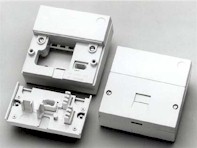
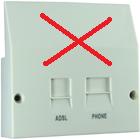
Only
proceed if…
- You have a standard NTE5 master socket with a removable lower
half - You have telephone extensions wired in the house
If you have the split ADSL/Phone Master socket, proceed only out of
interest, but leave the bellwires intact.
Personally I find that kind of ADSL/Phone twin socket unhelpful as it
does not allow the modem to be plugged into extension sockets.
If you decide to do this Bellwire fix using a standard BT master socket, the other benefit is
you can safely plug
the Hub into any phone extension socket in the house without problems (but see “ADSL Killers” later).
If you want to cut the science and go straight to the fix look
here
2. The Symptoms
BT Modems work with the exchange equipment to determine the fastest
stable speed that the exchange is happy with. It is optimised to give the
best speed considering the signal errors received.
This optimised speed is known as your “IP Profile” speed at the
exchange.
The “Downstream” speed displayed on your hub pages is the
Synchronisation (Sync) speed and is the initial speed negotiated with the
exchange equipment when you first connect the hub, based on their database
information and line condition.
I strongly recommend you spend some time diagnosing the actual speeds
you enjoy by reading my web page here and
not simply rely on what the hub tells you.)
Typical symptoms of Repetitive Electrical Impulse Noise (or “REIN”)
on the extensions when using the
BT home hub are when Sync speed starts high after reconnecting the hub to
the DSL line, then slows down to maybe a half or a quarter of
that speed after a couple of days. It can also cause connection drop-outs. Your IP
Profile speed and drop-outs may only improve if you can fix the noise problem.
To help you diagnose speeds, BT supply two websites. Firstly the
speedtester.bt.com site is recommended to
display the IP Profile and to measure Actual speeds from exchange to hub.
This must be run using Internet Explorer for best results. There is also a
“BT Broadband Speed checker” site to tell you the speed expectations at your
address.
You MUST use your
POSTCODE in that expectations site. If you use your phone number, as
an existing customer you will more likely get your current IP profile, and
if you do have a problem locally you want to know what you COULD be getting
rather than what you ARE getting – hence use POSTCODE!
If you compare the two sites, and the Profile speed is a lot less
that the Postcode Expectations speed, (say at leat 30 percent less) then
suspect either
- A noisy house installation
- A bad BT line
Be assured that this speed adjustment by the ISP is essential – the
alternative to managing the speed is an unstable connection. Whet you need
to do is to find out why.
3 Diagnosis
(the “Clean Socket” test)
If this test shows no improvement after three days, your wiring is
probably not the problem.
First check you are not using P2P or downloading too much (BT Option
3 caps at around 50 – 100Gb a month, but that figure is not published in
the Fair Usage Policy (FUP).
If you are certain you have not been capped under the FUP, having
done the Clean Socket test to eliminate your house wiring you are then well
armed to tell BT it’s their problem!
In order to see if your house wiring is affecting your speeds
you should go to the master socket i.e. the first white socket in the
property with BT or Openreach printed on it. (If it says Openreach you may
well have one of the new bellwire filtered sockets – see later).

This is the NTE5 master socketfitted up to 2007. House phone extensions
are wired into the removeable lower part of the socket to which the
homeowner is allowed to remove and add extensions.
Remove the lower half of the socket and let it hang. if you have hard
wired extensions they will be connected to this removeable part.
Plug a BT ADSL filter into the socket in the remaining part of the
socket still attached to the wall. Plug one phone into the filter, and the
Home Hub’s ADSL (Broadband) lead into the other socket in the filter.
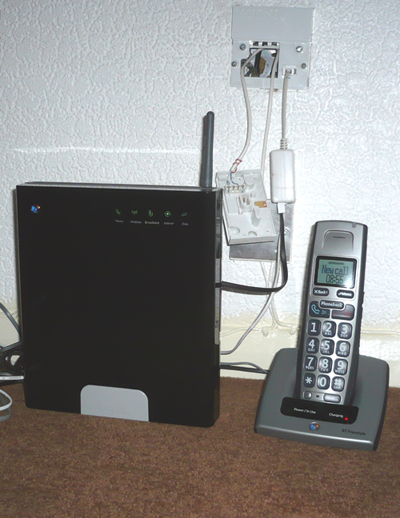
Leave the socket like this for THREE DAYS. Then repeat the speed
tests and see if your profile has improved significantly.
If the IP profile is much better at the end of the 3 days, you have a
problem with your extension wiring, and the most likely culprit is the
bellwire.
However the main twisted pair can also pick up interference so you
should also check routing of the extensions and avoid mains wires and
equipment such as microwaves, TVs and other radio devices like DECT phones.
Having a home hub, you are lucky in that you can use Wi-fi from the
Hub in its temporary position by the master socket, but if you have only
ethernet cable or USB, DO NOT EXTEND THE PHONE OR CABLE for this test, MOVE
THE PC NEARER THE HUB!! There is no point in eliminating the extension
wiring then adding more flexible extensions which contain their own
bellwires!
4 The Science.
At the Home Hub Forum a contributor codenamed Bramshot told me his story of the
BT engineer who removed his bellwire and the subsequent hike in speed. More
web research I did using Google and Yahoo also came up with the theory that
the “bell-wire” is the cause. (See other citations at the bottom of this
article).
The Bell Wire is the third wire on terminal 3(usually orange/white)
used in the standard BT extension wiring that was introduced in the early
1980’s when DIY extensions became legal, and BT relaxed their monopoly on
supply of phones.
From under the road or along a telegraph pole, your house is served
by just TWO wires. This third “bell-wire” is generated by the BT master
socket and enables actual bells on old type phones to ring using the 50
volt AC ringer signal. Modern phones have electronic ringers which do not
need the bell wire. Its other function is to stop other bells tinkling when
rotary dials are used, and it was always known as the “anti-tinkle wire” in
the 1980’s when we all experimented with DIY extensions.
On standard domestic phone with broadband and individual ADSL filters
you don’t need any wires apart from the two main conductors on terminals 2
and 5, usually blue/white and white/blue. This is because ADSL
filtersisolate the phones from the bellwire and recreate the function
in the filter. This makes the bellwire
totally redundant in a broadband enabled domestic phone system.
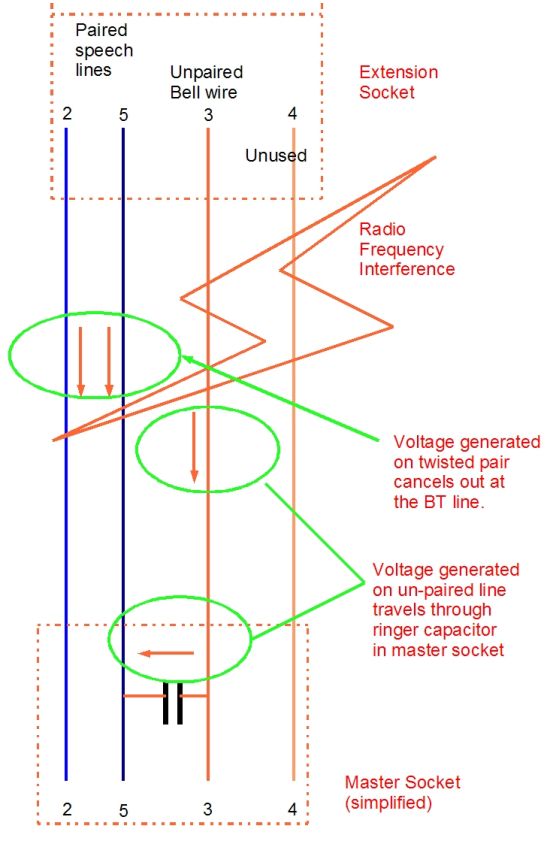
Leaving the bell wire in place creates a huge long antenna which
picks up radio frequency (RF) interference all over the house. The two
conductors that carry the voice and DSL signals are a “randomly twisted
pair” which carry current in opposite directions (from master socket to
extension socket and back again) so the RF interference cancels itself out.
The unpaired bell-wire cannot cancel out the RF.
There is also another redundant (white/orange; terminal 4) wire which
has never been used by BT on simple domestic wiring. Best to disconnect
this too to avoid confusion.
5. The DIY Cure.
The cure is to disconnect all wires in terminals 3 and 4 at the NTE5
master socket.
On the Master socket disconnect the wires that are connected to
terminal 3 of the removable face plate. May as well take the white/orange
wire from terminal 4 too – it is unused anyway. Look
herefor details.
If you have an old plain BT master socket you could snip out the
bellwire(s) from the back of the faceplate that go to the extension
sockets, although this is by law supposed to be done by BT. The bellwire
carries no current so I leave it to your conscience.
You are not supposed to fiddle with the two BT wires coming from
outside, and there is no need to anyway, unless you want to fit your own
replacement NTE5a socket. Again, it’s illegal to do so, but it’s not rocket
science. Provided you don’t allow the incoming wires to touch each other or
to touch anything else metal, you will do no damage, but again it’s illegal
in the UK so I can’t suggest fitting your own master sockets either – it’s
up to you, and if you can find a UK supplier.
The result is that throughout the extension system, you leave just
TWO WORKING CONDUCTORS on terminals 2 and 5, (white/blue and blue/white.)
N.B. This fix is LEGAL.
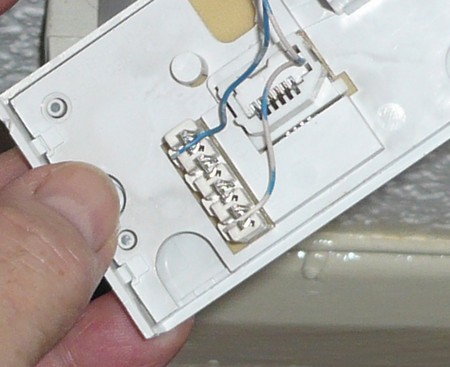
6. BT’s solution
More recent master sockets labelled “Outreach” rather than “BT”, will
most probably have the new inductor in the bellwire circuit. I tested one
of these with my bellwire reinstated. My IP profile remained at 3000k and
the sync speed dropped only minutely from 3684 to 3584kbps , so I can
confirm that the new faceplates do work almost as well at reducing bellwire
“REIN” noise as the bellwire being cut.
The photograph shows the difference between the new (LEFT) and old
(RIGHT). The new one has a cylindrical bulge in the lower removeable plate
that houses the inductor.
Unfortunately it may cost you for an engineer visit but ask your BT
sales helpdesk.
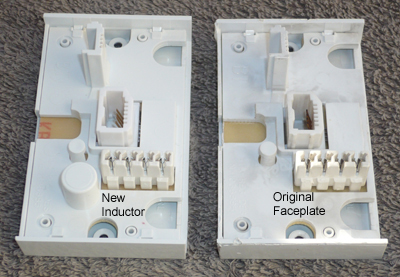
The way the original master seems to have been modified
is shown below. the inductor blocks high frequency interference.
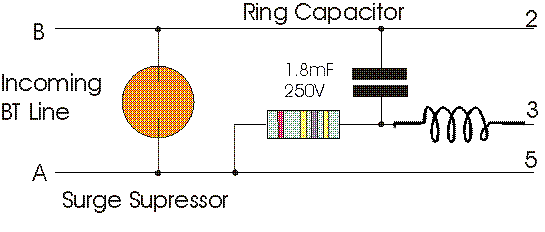
iPlate
They also have a
new idea – the “iPlate” (aka “BT Broadband Accelerator”) which fits between the old
type frontplate and the backplate
It CANNOT be used if you have
either the new type of filtered plate as above, or a double socket ADSL/Phone
master front plate.
See here for more details
7. THE ADSL KILLERS!
The pictured “DIY Extension Cables” are still on sale in “good
hardware shops” but are capable of killing your ADSL speed unless you have
an “iPlate” or bellwire-filtered master socket. The bellwire fix will
probably not help you if you have any of these killers in circuit.
Quite simply the 15m of bellwire plugs straight into the ringer capacitor
of a master socket and cannot be isolated without a scalpel and giving the wire a
vasectomy.
ONLY use proper round phone cable with loose random twisted solid
core wires and properly wired to the master socket faceplate (or extension
socket backplate if on a daisy-chain) using terminals 2 and 5 only.
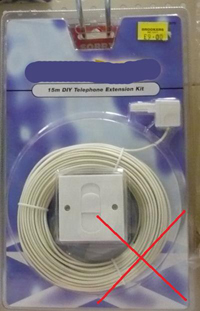
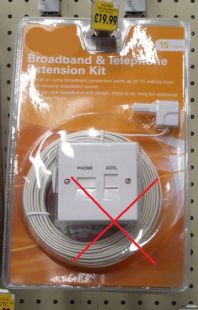
If you must use one of these nasty flat cable extensions, make sure it is
only plugged into a fixed extension wall socket where the bellwire has been
isolated at the master end, and make sure you fit the ADSL filter at the
end of the extension furthest from the wall socket. You can always fit an
additional fixed extension a few inches from the master with just the two
conductores on 2 and 5 terminals for this purpose.
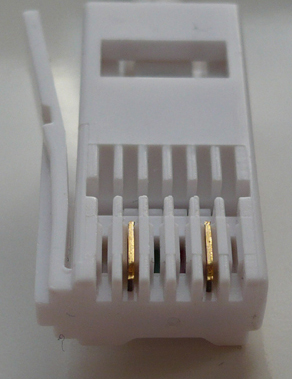
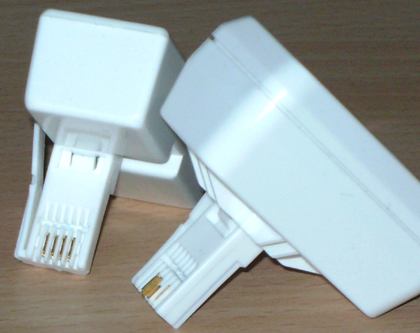
Even better this idea was emailed to me by Don J. The plug-in extension can
often be doctored by prising out the middle two pins which relate to the bellwire
(3) and unused (4) wires. Adapters can also be doctored the same way. This
will convert ADSL killers into 2-wire extensions. Use a compas point or
small sharp screwdriver. Right hand pic shows the brass pins half removed.
8. Other References
Master Socket (diagrams copied from
WPP site)
See how the
bell-wire on terminal 3 connects to BT “B” via the 1.8 mf capacitor which
has a low impedance to higher frequencies – i.e. a capacitor passes high
frequency noise signals through as though it was a conductor.
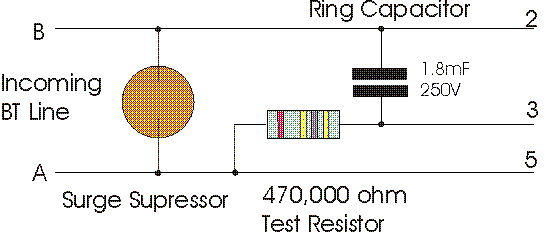
Standard domestic BT wiring – Disconnect wires at X.

DISCONNECT ORANGE CABLES ON TERMINALS 3 AND 4!!
Simply cut them or
pull them out of the faceplate terminals. They carry no voltage and are
quite safe to cut individually. Leave only the Blue/White wires on 2 and 5.
For details see
here
That will reduce RF interference to a minimum and increase your
stabilised throughput speed.
More supporting data I found since my own experiments can be found on
Related Pages
|
Page created by "Jarviser" & hosted by FileSaveAs. See the Jarviser Home Hub Index Page If you’ve found the content of this page of use, and want to say thanks, Jarviser’s charity of choice is Great Ormond Street Hospital. Please visit their site to make a donation Got a question about the BT Home Hub? Please ask in the FileSaveAs Home Hub Forum Disclaimer: Content on this page was not originated by FileSaveAs, and is hosted ‘as-is’ as a service to Home Hub users. FileSaveAs accepts no responsibility for the content on this page. Visitors use information on this page at their own risk. Contents may not be reproduced without permission. Original copyright for content on this page rests with Jarviser unless otherwise stated. FileSaveAs Site Terms apply. |

